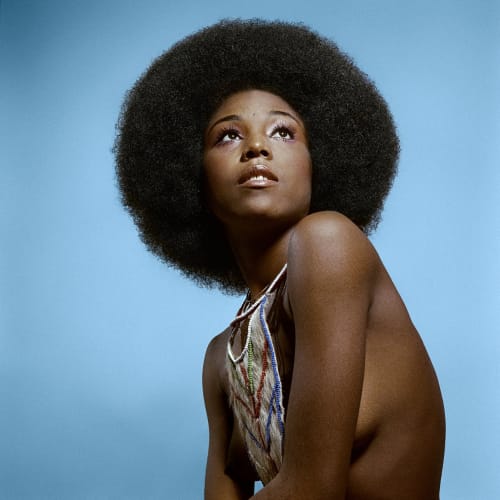Willis, Deborah. “Kwame Brathwaite (1938-2023),” Artforum, April 20, 2023.
KWAME BRATHWAITE WAS FAMILY! He taught me about the possibilities of photography and what it means to document everyday life in Harlem. The last time I saw Kwame was at Melba’s Restaurant on a Sunday afternoon with his family. All the church folks were there. He and his wife greeted me as they always did with a welcoming smile. Kwame’s warmth and compassion for community guided me to a phrase I call upon often: “Art teaches us that every life has value.”
In 1969, I moved from Philadelphia to New York City to study at the Germain School of Photography in Lower Manhattan. The first photographer I met in the city was Kwame Brathwaite at a political rally in the Countee Cullen Library on West 136th Street. I was surprised and honored to see him along with other Black activists I heard speak at conferences in Philadelphia, listened to on the radio, saw on television, and read about in the papers. I knew his name because he and his brother, Elombe Brath, helped to organize the “Naturally” fashion shows where models wore Afro hairstyles, which I was proudly sporting at that time. My mom had a salon and often traveled to New York to see the beauty pageants. Kwame was at the rally to take pictures. I can still recall the kindness in his quiet greeting when I told him I was in NYC to practice photography and his smile as he turned away and continued to capture the room through his lens. The late Queen Mother Moore was also in attendance, and she was receiving lots of love from younger activists who had traveled from afar to attend the meeting. Queen Mother Moore was a Black Nationalist born in Louisiana, a Garveyite who remains memorable to me because she shared her views on reparations at that meeting.
In 1968, Kwame traveled to document political and cultural movements alongside everyday life in West and East Africa. A photo essay from this trip was televised on WABC’s program “Like It Is” with Gil Noble. I remember that segment with great pride. It was Kwame’s stories that encouraged me to take a trip to Ghana in 1970. Over the next decade, he covered protests and happenings in the US and Africa such as the funeral of Kwame Nkrumah, the Ali-Foreman heavyweight championship fight in Zaire, and the Wattstax benefit concert. I wanted to include his portraits of the beauty shows in a book I was writing on Black photographers, but he was insistent that I use a portrait of Thomas Isidore Noël Sankara, pan-Africanist and the President of Burkina Faso, instead. At the time I did not know how significant Sankara was to freedom movements. I learned from Kwame that he was known as “Africa’s Che!” After years of seeing him at rallies in Harlem and art conferences, we continued to share stories about our life in photography. We often met at the Studio Museum in Harlem and attended local exhibitions at the Harlem State Office Building Gallery. We reconnected again in 1980 when Kwame invited me to participate in events organized by the National Conference of Artists.
Kwame’s photographs document the activism of empowerment and continue to affirm an unwavering commitment to Africa’s political movements, aesthetics, and culture. The impact of seeing his photographs of Black women on popular album covers expanded the consumer consciousness and reflected a changing society which informed us that “Black is beautiful” and that beauty is power through the lens of Kwame Brathwaite.

